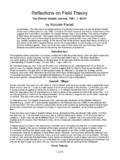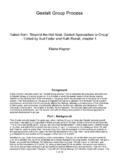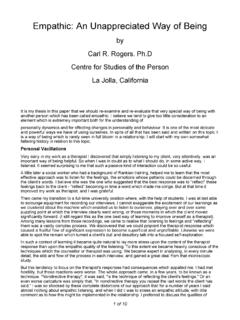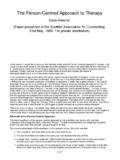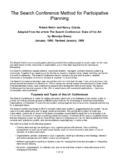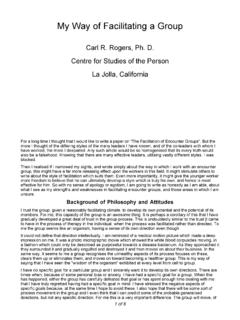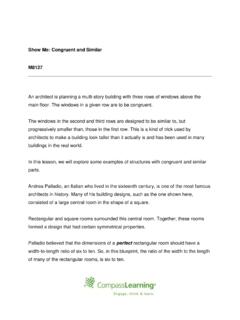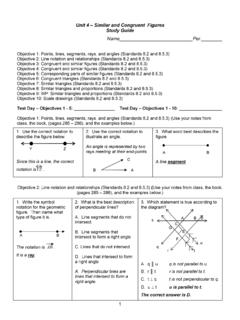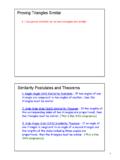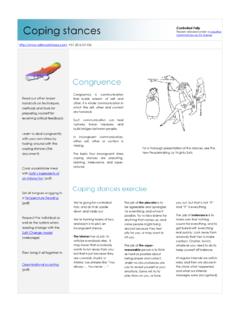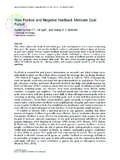Transcription of Authenticity, Congruence and Transparency - …
1 authenticity , Congruence and Transparency Germain Lietaer Although Rogers had always attached great importance to the therapist's authenticity (see for example Rogers, 1951, p. 19), it was not until his 1957 paper about the 'necessary and sufficient conditions' that he mentioned it explicitly as a separate therapeutic condition, along with empathy and acceptance. From 1962. on, he even called it the most fundamental of all three basic attitudes, and continued doing this in his later works. Here is how Rogers describes it: Genuineness in therapy means that the therapist is his actual self during his encounter with his client. Without facade, he openly has the feelings and attitudes that are flowing in him at the moment. This involves self-awareness; that is, the therapist's feelings are available to him to his awareness - and he is able to live them, to experience them in the relationship, and to communicate them if they persist. The therapist encounters his client directly, meeting him person to person.
2 He is being himself, not denying himself. Since this concept is liable to misunderstanding, let me state that it does not mean that the therapist burdens his client with overt expression of all his feelings. Nor does it mean that the therapist discloses his total self to his client. It does mean, however, that the therapist denies to himself none of the feelings he is experiencing and that he is willing to experience transparently any persistent feelings that exist in the relationship and to let these be known to his client. It means avoiding the temptation to present a facade or hide behind a mask of professionalism, or to assume a confessional-professional attitude. It is not simple to achieve such reality. Being real involves the difficult task of being acquainted with the flow of experiencing going on within oneself, a flow marked especially by complexity and continuous change .. (1966, ). This definition implies clearly that genuineness has two sides: an inner one and an outer one.
3 The inner side refers to the degree to which the therapist has conscious access to, or is receptive to, all aspects of his own flow of experiencing. This side of the process will be called ' Congruence '; the consistency to which it refers is the unity of total experience and awareness. The outer side, on the other hand, refers to the explicit communication by the therapist of his conscious perceptions, attitudes and feelings. This aspect is called ' Transparency ': becoming 'transparent' to the client through communication of personal impressions and experiences. Although this splitting up of genuineness into two components may be slightly artificial, we find it justified from a didactic point of view as well as clinically meaningful. Indeed, a congruent therapist may be very or minimally transparent, according to his style or orientation; a transparent therapist may be congruent, or he may be incongruent (something which makes him or her a 'dangerous' therapist).
4 In a first point, we will discuss the concept of Congruence , which has always been given the most weight in Rogers'. definition. In a second one, we will then deal with Transparency . 1. Congruence Why did Rogers come to attach so much importance to the therapist's Congruence , and why did he even come to see it as the most fundamental basic attitude? We hope to answer this question gradually, while further explaining the concept itself. Personal Presence Rogers was always opposed to the idea of the therapist as a 'white screen'. He designed a 'face-to-face'. type of therapy, in which the therapist is highly involved with the client's experiential world, and in which he, consequently, shows little of himself. Yet he does show his involvement in an open and direct way, without hiding his real feelings behind a professional facade. He tries to be himself without artificiality and haziness. By adopting such a 'natural', spontaneous attitude, the client-centred therapist certainly does not favour the process of regression and transference; but Rogers did not see this 'detour-process' as essential to personality change.
5 More than the psychoanalysts, he believed in the therapeutic value of a 'real'. relationship between client and therapist, and saw other, more important advantages in it as well. In such a working relationship, the therapist serves as a model: his Congruence encourages the client to take risks himself in order to become himself. Along with this, Rogers gradually came to consider the therapist's Congruence as a crucial factor in establishing trust, and came to emphasise the idea of acceptance and 1 of 12. empathy only being effective when they are perceived as genuine: Can I be in some way which will be perceived by the other person as trustworthy, as dependable or consistent in some deep sense? Both research and experience indicate that this is very important, and over the years I have found what I believe are deeper and better ways of answering this question. I used to feel that if I fulfilled all the outer conditions of trustworthiness - keeping appointments, respecting the confidential nature of the interviews, etc.
6 - and if I acted consistently the same during the interviews, then this condition would be fulfilled. But experience drove home the fact that to act consistently acceptant, for example, if in fact I was feeling annoyed or sceptical or some other non-acceptant feeling, was certain in the long run to be perceived as inconsistent or untrustworthy. I have come to recognise that being trustworthy does not demand that I be rigidly consistent but that I be dependably real. The term 'congruent' is one I have used to describe the way I would like to be. By this I mean that whatever feeling or attitude I am experiencing would be matched by my awareness of that attitude. When this is true, then I am a unified or integrated person in that moment, and hence I can be whatever I deeply am. This is a reality which I find others experience as dependable. (Rogers, 1961, ). This also means that the therapist should give priority to discussing his own feelings whenever they persistently stand in the way of the other two basic attitudes.
7 Initially, Rogers considered such moments of self-expression as a 'help in need', as a therapist's last resort in discarding obstacles to his involvement with the client's experiential world. Gendlin, on the other hand, emphasises more the gain, for therapist and client, resulting from daring to present oneself as 'not perfect': ' Congruence ' for the therapist means that he need not always appear in a good light, always understanding, wise, or strong. I find that, on occasion, I can be quite visibly stupid, have done the wrong thing, made a fool of myself. I can let these sides of me be visible when they have occurred in the interaction. The therapist's being himself and expressing himself openly frees us of many encumbrances and artificialities, and makes it possible for the schizophrenic (or any client) to come in touch with another human being as directly as possible. (Gendlin, 1967, ). The personal presence of the therapist should also be apparent from his concrete methodology, from the specific interventions and procedures used to facilitate and deepen the client's discourse.
8 Important here is that the 'technique' should rest on an underlying attitude, that the therapist should stand behind it with his whole being (Kinget, 1959, ), and that his work method should suit his personality. Rogers noticed 'with horror' in some of his pupils how reflecting feelings had deteriorated into aping, into a 'wooden technique', no longer carried by an inner attitude which emanates from an attempt to understand and check this understanding (Rogers, 1962, 1986; Bozarth, 1984). Rogers' view on the therapist's contribution thus increasingly evolved towards a metatheory, in which a number of basic attitudes are emphasised and in which concrete recipes and formulas of intervention have faded into the background. Gendlin writes about this evolution: Gone are formulas - even that most characteristic of client-centred modes of responding, which was called 'reflection of feeling'. As the term 'empathy' implies, we strive as always to understand and sense the client's feeling from his own inward frame of reference, but now we have a wider scope of different behaviours with which therapists respond to clients.
9 In fact, I believe that it was in part the undesirable tendency toward formulas and stereotyped ways of responding which perhaps led Rogers to formulate this condition of ' Congruence ' as essential. (Gendlin, 1967, ). Because of the prime importance of the therapist's authenticity - but also perhaps because he was no great believer in the power of technique per se - Rogers thus emphasises respect for each therapist's personal style. He does not want to put him in a methodological strait-jacket which would not suit his nature. That he is very broad-minded about this becomes obvious, for instance in his comment about the often widely diverging working methods of the therapists in the schizophrenic study: Perhaps the deepest of these learnings is a confirmation of, and an extension of, the concept that therapy has to do with the relationship, and has relatively little to do with techniques or with theory and ideology. In this respect I believe my views have become more, rather than less, extreme.
10 I. believe it is the realness of the therapist in the relationship which is the most important element. It is when the therapist is natural and spontaneous that he seems to be most effective. Probably this is a 'trained humanness' as one of our therapists suggests, but in the moment it is the natural reaction of this person. Thus our sharply different therapists achieve good results in quite different ways. For one, an impatient, no-nonsense, let's put-the-cards-on-the-table approach is most effective, because in such an approach he is most openly being himself. For another it may be a much more gentle and more obviously warm approach, because this is the way this therapist is. 2 of 12. Our experience has deeply reinforced and extended my own view that the person who is able openly to be himself at that moment, as he is at the deepest levels he is able to be is the effective therapist. Perhaps nothing else is of any importance (Rogers, 1967, ). As will be discussed further on, this respect for the therapist's own style is no passport to 'reckless experimenting'.
